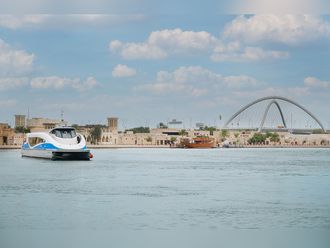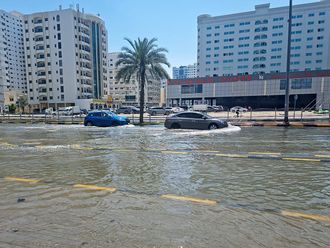Abu Dhabi: The area is filled with lush greenery, and the streets are lined by date palms that droop with fruits in summer. Nearby, the soothing sounds of a splashing fountain add a touch of calm for the groups of people that wait for the many buses passing through the quiet locality.
This is the area near the Abu Dhabi Judicial Department and Sharia Court (ADJD), a regal building that is featured on the Dh200 bank note. First opened in 1982, the building holds pride of place in its neighbourhood, and its glass dome that shines golden in the morning sun is known to be the biggest glass dome in the emirate.
According to official records, this building has undergone numerous renovations that have transformed the premises into a modern judicial facility. In its most recent renovation in 2008, six small buildings were added to the older main structure, and the ADJD now spans three floors over an area of 28,000 square metres.
As it now stands, renovations are still being carried out on its external façade. Internally, the ADJD houses various legal departments, including the offices of the marriage registration section, the public prosecution and the criminal courts.
Although the building has grown over the years, there is still ample space in the surrounding landscape to expand the facility, which is presumably why the area was first chosen to house the ADJD. For, even as the number of government departments in the vicinity increases, the locality has managed to remain uncrowded and largely free of congestion.
Iconic structure
Because it is free from congestion, the neighbourhood is an ideal location for the Zayed Sports City, one of the most popular stadiums in the capital and the largest multi-purpose stadium in the Gulf. This iconic structure, which is located just next to the ADJD premises, is also featured on the Dh200 bank note. And although it was inaugurated as early as 1980, it has managed to remain one of the capital's premier sporting destinations during its three decades of existence.
In fact, for the past two years, the Sports City's massive football stadium, with seating capacity for 43,000 football fans, has hosted the immensely popular Fifa Club World Cup. Apart from other high-profile football events, the facility also houses seven tennis courts, a 40-lane bowling complex, one of the first ice rinks in the city, a fitness centre and training pitches for football, softball and rugby.
Surrounding the two prominent structures of the ADJD and the Sports City are a variety of government departments, including the Health Authority Abu Dhabi, the National Centre for Aviation Studies, and the Abu Dhabi Authority for Culture and Heritage.
While residents might visit the official buildings to avail of various services, one of the biggest attractions in the area is a shopping mall that houses Carrefour, a major international hypermarket chain, as well as a variety of smaller stores selling everything from jewellery to opticals.
Lisa Wallsten, a 30-year-old mother from Sweden, told Gulf News she drives down to the Carrefour outlet at least once a week to stock up on her groceries and supplies.
Growing popularity
"I live nearby and it is easy for me to bring my one-year-old to Carrefour, which is conveniently close. In addition, the store has a range of items, which is why I prefer to shop here," she explained.
It is not only people living nearby that frequent the outlet.
Maimoon Shareef, 56, a public relations officer from India said he prefers to make the 20-minute drive from his home to shop at Carrefour.
"My wife and I have lived in Abu Dhabi for more than 30 years, and we have seen this particular area grow in prominence and popularity. Other than shopping at the Carrefour, however, I have not visited too many of the government buildings," Shareef said.
"There was only once when I happened to visit the ADJD premises 15 years ago to file some kind of application, and even then, I had found the building imposingly beautiful," he added.
According to Shareef, the neighbourhood is one of the busiest in the capital in terms of the number of services offered.
"Yet, it still manages to retain its sense of calm," he said. Behind the Carrefour outlet is an extremely busy bus stop, which is serviced by numerous Department of Transport bus routes. This vantage point also gives residents a bird's eye view of the Shaikh Zayed Grand Mosque.
One of the capital's most popular public parks, the Old Airport Garden, is also located in the area.
"All eight of my children have grown up visiting this park with its swings and slides, which I am certain must feature prominently in their memories," Mohammad Al Hashemi, an Emirati police officer, told Gulf News.
"Even now, we frequently visit the park, especially on weekends in the winter. And often, we pass by the Carrefour to do a bit of shopping on our way home," Al Hashemi added.
To future generations, the area will look different as a result of the Abu Dhabi Capital Plan 2030. According to the framework plan released by the Abu Dhabi Urban Planning Council (UPC), the Sports City and the ADJD, as well as all surrounding areas, will become part of the capital's future Grand Mosque District.
While existing government departments will continue to be located in the district, the UPC plan also details how the area, which is situated at the ‘strategic entryway to Abu Dhabi island', will be developed with residential housing and an increase in retail and employment facilities.
Despite the changes, the majestic Shaikh Zayed Grand Mosque will continue to be the most prominent feature in the district.
Government departments in the area
The area surrounding the Abu Dhabi Judicial Department and Zayed Sports City houses many official buildings and headquarters, including the following:
- Health Authority Abu Dhabi
- Centre for Documentation and Research
- Abu Dhabi Authority for Culture and Heritage
- National Centre for Aviation Studies
- General Civil Aviation Authority
- Abu Dhabi National Hotels Company
- Emirates Identity Authority












